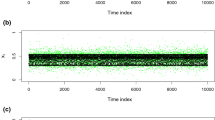Abstract
Recurrence plot analysis is a well-established method to analyse time series in numerous areas of research. However, it has exponential computational and spatial complexity. As the main result of this paper, a technique for the computation of recurrence quantitative analysis (RQA) is outlined. This method significantly reduces spatial complexity of computation by computing RQA directly from the time series, optimizing memory accesses and reducing computational time. Additionally, parallel implementation of this technique is tested on the Salomon cluster and is proved to be extremely fast and scalable. This means that recurrence quantitative analysis may be applied to longer time series or in applications with the need of real-time analysis.



Similar content being viewed by others
References
Acharya UR, Sree SV, Chattopadhyay S, Yu W, Ang PCA (2011) Application of recurrence quantification analysis for the automated identification of epileptic EEG signals. Int J Neural Syst 21(3):199–211. http://dblp.uni-trier.de/db/journals/ijns/ijns21.html#AcharyaSCYA11
Balibrea F (2016) On problems of topological dynamics in non-autonomous discrete systems. Appl Math Nonlinear Sci 1(2):391–404. https://doi.org/10.21042/AMNS.2016.2.00034. http://journals.up4sciences.org/applied_mathematics_and_nonlinear_sciences/article/on_problems_of_topological_dynamics_in_non_autonomous_discrete_systems.html
Bradley E, Kantz H (2015) Nonlinear time-series analysis revisited. Chaos 25(9):097610. https://doi.org/10.1063/1.4917289 arXiv:1503.07493
Builes-Jaramillo A, Marwan N, Poveda G, Kurths J (2017) Nonlinear interactions between the Amazon river basin and the tropical North Atlantic at interannual timescales. Clim Dyn. https://doi.org/10.1007/s00382-017-3785-8
Center INS (2015) Salomon cluster. https://docs.it4i.cz/salomon/introduction/
Firooz SG, Almasganj F, Shekofteh Y (2017) Improvement of automatic speech recognition systems via nonlinear dynamical features evaluated from the recurrence plot of speech signals. Comput Electr Eng 58:215–226. https://doi.org/10.1016/j.compeleceng.2016.07.006. http://www.sciencedirect.com/science/article/pii/S0045790616301781
Flake GW (1998) The computational beauty of nature computer explorations of fractals, chaos, complex systems, and adaptation. MIT Press, Cambridge
Forum MP (1994) MPI: a message-passing interface standard. Tech. Rep., Univerisity of Tennessee, Knoxville, TN, USA
Fousse L, Hanrot G, Lefèvre V, Pélissier P, Zimmermann P (2007) MPFR: a multiple-precision binary floating-point library with correct rounding. ACM Trans Math Softw. https://doi.org/10.1145/1236463.1236468
Fukino M, Hirata Y, Aihara K (2016) Coarse-graining time series data: recurrence plot of recurrence plots and its application for music. Chaos Interdiscip J Nonlinear Sci 26(2):023,116. https://doi.org/10.1063/1.4941371
Hemakom A, Chanwimalueang T, Carrin A, Aufegger L, Constantinides AG, Mandic DP (2016) Financial stress through complexity science. IEEE J Sel Topics Signal Process 10(6):1112–1126. https://doi.org/10.1109/JSTSP.2016.2581299
Hermann S (2005) Exploring sitting posture and discomfort using nonlinear analysis methods. IEEE Trans Inf Technol Biomed 9(3):392–401. https://doi.org/10.1109/TITB.2005.854513
Karain WI, Qaraeen NI (2017) The adaptive nature of protein residue networks. Proteins Struct Funct Bioinform 85(5):917–923. https://doi.org/10.1002/prot.25261
Lampart M, Martinovič T (2017) A survey of tools detecting the dynamical properties of one-dimensional families. Adv Electr Electron Eng 15(2):304–313. https://doi.org/10.15598/aeee.v15i2.2314. http://advances.utc.sk/index.php/AEEE/article/view/2314
Lancia L, Voigt D, Krasovitskiy G (2016) Characterization of laryngealization as irregular vocal fold vibration and interaction with prosodic prominence. J Phon 54:80–97. https://doi.org/10.1016/j.wocn.2015.08.001. http://www.sciencedirect.com/science/article/pii/S0095447015000662
Manuca R, Savit R (1996) Stationarity and nonstationarity in time series analysis. Physica D Nonlinear Phenom 99(2):134–161. https://doi.org/10.1016/S0167-2789(96)00139-X. http://www.sciencedirect.com/science/article/pii/S016727899600139X
Martinovič T, Zitzlsberger G (2017) Rqa_hpc. https://code.it4i.cz/ADAS/RQA_HPC
Marwan N, Romano MC, Thiel M, Kurths J (2007) Recurrence plots for the analysis of complex systems. Phys Rep 438(5):237–329. https://doi.org/10.1016/j.physrep.2006.11.001. http://www.sciencedirect.com/science/article/pii/S0370157306004066
Meng HB, Song MY, Yu Y-F, Wu J-H (2016) Recurrence quantity analysis of the instantaneous pressure fluctuation signals in the novel tank with multi-horizontal submerged jets. Chem Biochem Eng Q 30(1):19–31. https://doi.org/10.15255/CABEQ.2014.2043
Mesin E, Monaco A, Cattaneo R (2013) Investigation of nonlinear pupil dynamics by recurrence quantification analysis. BioMed Res Int. https://doi.org/10.1155/2013/420509
Nalband S, Sundar A, Prince AA, Agarwal A (2016) Feature selection and classification methodology for the detection of knee-joint disorders. Comput Methods Programs Biomed 127:94–104. https://doi.org/10.1016/j.cmpb.2016.01.020. http://www.sciencedirect.com/science/article/pii/S0169260716000092
Olyaee MH, Yaghoubi A, Yaghoobi M (2016) Predicting protein structural classes based on complex networks and recurrence analysis. J Theor Biol 404:375–382. https://doi.org/10.1016/j.jtbi.2016.06.018. http://www.sciencedirect.com/science/article/pii/S0022519316301527
Rawald T, Sips M, Marwan N, Dransch D (2014) Fast computation of recurrences in long time series. Springer, Cham, pp 17–29. https://doi.org/10.1007/978-3-319-09531-8_2
Rawald T, Sips M, Marwan N (2017) Pyrqaconducting recurrence quantification analysis on very long time series efficiently. Comput Geosci 104:101–108. https://doi.org/10.1016/j.cageo.2016.11.016. http://www.sciencedirect.com/science/article/pii/S0098300416307439
Spiegel S, Jain JB, Albayrak S (2014) A recurrence plot-based distance measure. Springer, Cham, pp 1–15. https://doi.org/10.1007/978-3-319-09531-8_1
Spiegel S, Schultz D, Marwan N (2016) Approximate recurrence quantification analysis (aRQA) in code of best practice. Springer, Cham, pp 113–136. https://doi.org/10.1007/978-3-319-29922-8_6
Takens F (1981) Detecting strange attractors in turbulence. Springer, Berlin, pp 366–381. https://doi.org/10.1007/BFb0091924
Webber CL, Zbilut JP (1994) Dynamical assessment of physiological systems and states using recurrence plot strategies. J Appl Physiol 76(2):965–973. http://jap.physiology.org/content/76/2/965. http://jap.physiology.org/content/76/2/965.full.pdf
Zbilut JP, Webber CL (1992) Embeddings and delays as derived from quantification of recurrence plots. Phys Lett A 171(3):199–203. https://doi.org/10.1016/0375-9601(92)90426-M. http://www.sciencedirect.com/science/article/pii/037596019290426M
Acknowledgements
This work was supported by The Ministry of Education, Youth and Sports from the National Programme of Sustainability (NPU II) project “IT4Innovations excellence in science - LQ1602” and by the IT4Innovations infrastructure which is supported from the Large Infrastructures for Research, Experimental Development and Innovations project “IT4Innovations National Supercomputing Center LM2015070”. This work was partially supported by grant of SGS No. SP2017/182 “Solving graph problems on spatio-temporal graphs with uncertainty using HPC”, VŠB - Technical University of Ostrava, Czech Republic.
Author information
Authors and Affiliations
Corresponding author
Rights and permissions
About this article
Cite this article
Martinovič, T., Zitzlsberger, G. Highly scalable algorithm for computation of recurrence quantitative analysis. J Supercomput 75, 1175–1186 (2019). https://doi.org/10.1007/s11227-018-2350-5
Published:
Issue Date:
DOI: https://doi.org/10.1007/s11227-018-2350-5




